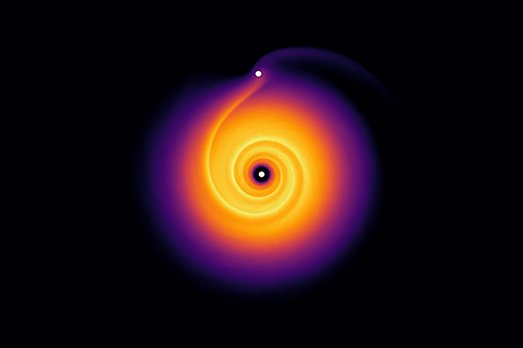
Three baby planets found around a faraway star for the very first time.
Up until now, scientists have only been able to observe these “protoplanetary discs” by themselves, and then actual planets after the disc has disappeared, said astrophysicist Christophe Pinte from Monash University.
These discoveries, by contrast, are still emerging from the disc around a very young star.
Dr Pinte is the lead author of one of two papers describing the discoveries, published today in Astrophysical Journal Letters.
The three planets are all very large — in the ballpark of infant, alien Jupiters.
“It’s already quite massive, roughly twice the mass of Jupiter, and it can probably grow a little bit more,” Dr Pinte said of the world discovered by his team.
The whole system is also extremely young — and that is what makes it exciting, explained Dr Pinte.
“There have been lots of discoveries of planets around old stars, but this system is only 4 million years old and it’s still in the process of formation.”
For comparison: our solar system has been spinning for 4.5 billion years.
So it’s very early days for this new system, which is 330 light years from Earth and was discovered in data collected by the Atacama Large Millimetre/submillimetre Array (ALMA) in Chile.
Planets form in the disc of dirt and gas that spins around a new star.
Dr Pinte and his colleagues stumbled upon the new baby planet while trying to understand the disc structure around a young star called “HD163296”.
While examining how carbon monoxide gas (CO) was flowing around the star, they noticed a “kink” in its otherwise smooth trajectory.
“We found that the disc deviation corresponded exactly to what a computer simulation of a planet in a disc predicted,” Dr Pinte said.
“We’re pretty confident that this is the only explanation for what we are seeing in the disc.”
Jonti Horner, an astrophysicist at the University of Southern Queensland who was not involved in the study, said the planet was an exciting discovery. He likened it to seeing a human baby kick inside the womb.
“We’re talking about a baby planet that is revealed from how it is stirring and perturbing the very material from which it is being born,” Professor Horner said.
This particular brand new world is also further from its star than any other planet yet discovered, Dr Pinte said.
“Nobody was expecting to find such a massive planet so far from the star. There’s not much material to form a planet out there.”
At eight times the distance between Neptune and the Sun, the planet’s orbit is not really comparable to anything in our solar system, he added.
“But it can be useful to understand if our solar system is typical, or if it’s an exception.”
The other two new baby planets also have very distant orbits, about three and five times larger than Neptune’s.
Richard Teague from the University of Michigan, lead author of the second paper, said the discoveries were possible because ALMA can stare at a system where gas rotates at about 5 km per second, and detect velocity changes as small as a few metres per second.
“This allows us to find very small deviations from the expected normal rotation in a disk,” Dr Teague said in a statement.
Baby planet boom imminent
Professor Horner said the novelty of these discoveries can shine a new light on our own solar system.
“Results like this reveal that the diversity of planets is far greater than we ever would have imagined,” he said.
HD163296 is approximately 4 million years old, 330 light years away from our Sun and already twice its size.
“It’s a tantalising clue that massive stars do form massive planets,” he said.
“It might be a common theme among exoplanets that more massive stars can have more distant, more massive planets.”
ALMA, the telescope that made it all possible, is a network of 66 interconnected radio dishes built high in the Atacama Desert, where the air is frigid and dry.
It has a crystal-clear view of the heavens and a level of precision that only comes from combining multiple instruments.
“It’s only possible to [detect] it with high-resolution observations, and with a lot of antennas which have only been available in the last few years,” Dr Pinte said.
“These new methods to detect planets while they are still forming means it’s just the beginning of proto-planet discovery.
Professor Horner said the study was a lovely example of how modelling and observation can go hand-in-hand to explain the previously unexplained.
“There’s still so much to learn — and that’s why results like this are so exciting. They open our eyes to the full variety of what is out there.”













